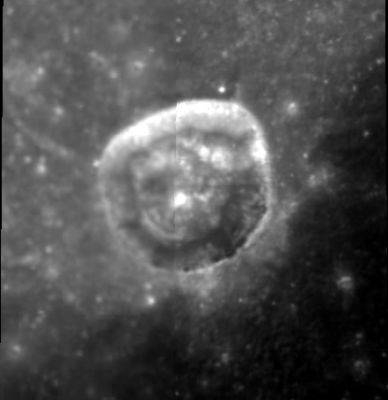Lichtenberg
Contents
Lichtenberg
|
Lat: 31.8°N, Long: 67.7°W, Diam: 20 km, Depth: 2.77 km, Rükl 8, Copernican |
Images
LPOD Photo Gallery Lunar Orbiter Images Apollo Images
Maps
(LAC zone 38A1) LAC map Geologic map LM map
Description
Description: Elger
(IAU Directions) LICHTENBERG.--A conspicuous little ring-plain, about 12 miles in diameter, in an isolated position on the Mare, some distance N. of Briggs. It was here that Madler records having occasionally noticed a pale reddish tint, which, though often searched for, has not been subsequently seen.
Description: Wikipedia
Additional Information
- Depth data from Kurt Fisher database
- Westfall, 2000: 2.77 km
- Viscardy, 1985: 1.2 km
- Cherrington, 1969: 1.18 km
- Satellite crater Lichtenberg B is on the ALPO list of bright ray craters.
- TSI = 15, CPI = 15, FI = 20); MI =50 Smith and Sanchez, 1973
- The unnamed ghost crater which is a little larger than Lichtenberg itself, and touching Lichtenberg's northwestern rim, is an interesting target for all dedicated observers of this region in Oceanus Procellarum. - DannyCaes Dec 5, 2009
- Small ghost crater between Lichtenberg A and Lichtenberg AA (both bowl-shaped craters are located east-southeast of Lichtenberg itself). See also P. 31-14 in NASA's Apollo 17 Preliminary Science Report for orbital close-up photograph.- DannyCaes Oct 29, 2015
Color effect near Lichtenberg
As described by Harold Hill in A Portfolio of Lunar Drawings, page 94:
- The Lichtenberg crater - a relatively small isolated ring 12 miles in diameter - is a celebrated object because it was here between the years 1830 and 1840 that Madler observed a strong reddish tint closely east of the crater. No one appears to have seen this subsequently until its recovery in 1940 by Barcroft in the USA when it was described as 'a pronounced reddish-brown'. Haas, at a later date, observed the same effect and in 1951 Baum in the UK reported a rose-pink coloration which persisted for a time and then faded.
- Between 0115 and 0320 on April 1 1988 (no significance in the date!) the author saw, for the first time in his experience, rosy-tinged areas fringing the northern edge of the lava sheet. The moon had hitherto always looked quite neutral in colour to his eyes but the effect on April 1 was unmistakeable and certainly not due to atmospheric dispersion or other false effects, because a most careful check was made with bright objects, such as Lavoisier A. The telescope employed was a 10" reflector using various eyepieces as a safeguard, but the colour persisted until weather conditions deteriorated. The area has been described as 'red sensitive' but, if so, it is curious that the coloration is rarely in evidence, even when specially looked for under the most suitable conditions. There the matter must rest....at least for now.
See also: Colored regions on the moon's surface
Nomenclature
- Named for Georg Christoph Lichtenberg (1742-1799), a German physicist. Lichtenberg was a colleague of Tobias Mayer, and edited one volume of Mayer's unpublished papers, including his celebrated lunar map. Lichtenberg also compiled a list of the names of 69 of the formations depicted on Mayer's map as he believed they appeared in the systems of Riccioli and Hevelius.
- Lichtenberg was Catalog Number 1867 in the original IAU nomenclature of Named Lunar Formations. The name is attributed to Beer and Mädler.
- Lichtenberg Epsilon (hill west of Lichtenberg), Lichtenberg Beta (hill northeast of Lichtenberg), see chart SLC F2 (System of Lunar Craters, 1966) and also page 247 in Tony Dethier's Maanmonografieen (VVS-Vereniging Voor Sterrenkunde, 1989).
LPOD Articles
LROC Articles
Lichtenberg B Flow (the bowl-shaped crater east-northeast of Lichtenberg itself).
Lovely Lichtenberg B
Bibliography
Harold Hill. A Portfolio of Lunar Drawings, pages 94, 95, 96.
A certain Lichtenberg and a round black spot, in the Sourcebook Project (William R. Corliss)
- In Mysterious Universe, a handbook of astronomical anomalies (1979) :
- Page 48: A Supposed New Interior Planet (Monthly Notices of the Royal Astronomical Society, 1859). Note: this Lichtenberg is mentioned here (in this article) because of an observation of a round black spot in transit across the disc of the sun, on november the 19th, 1762. Was this observer Georg Christoph Lichtenberg? - DannyCaes Apr 3, 2015
